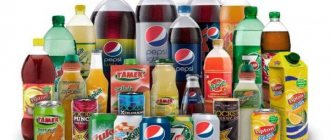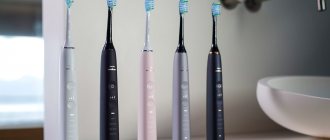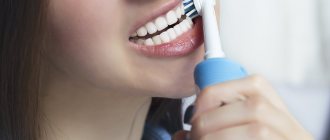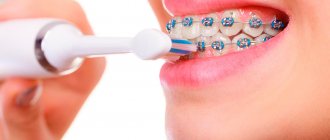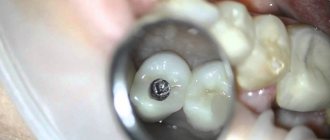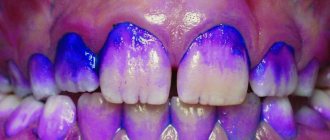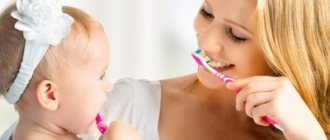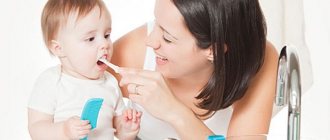It is important to keep baby teeth healthy, despite the fact that they are replaced by molars over time, because the latter depend on the quality of the former. Without proper cleaning, caries quickly develops on baby teeth, which can turn into permanent ones, sometimes even at the stage of their formation. In addition, early loss of baby teeth often causes permanent teeth to shift and cause problems with bite. To avoid these negative consequences, it is important to take care of your teeth from childhood, and in this article we will tell you how to teach your child to do this.
Teaching your baby to take care of his teeth
When should you start brushing your teeth?
From the moment the first tooth appears, which can erupt between the ages of five and eight months. Most often, the central incisors on the lower jaw appear first.
This is preceded by a period when the gums swell and bother the child. To alleviate the condition, you can give your baby a teething brush - it looks just like a regular one, but has thick and soft rubber bristles that massage the gums without injuring them. The baby will hold it himself, move it along the gums, bite the bristles to relieve itching, so he will quickly get used to the brush and the teeth cleaning procedure.
The teether has soft and thick bristles
When a child's first incisors appear, it is important to clean them with a children's toothbrush with rubber bristles. This procedure cannot be neglected, since at this age the baby eats liquid food, and only solid food (for example, raw carrots or apples) contributes to the process of self-cleaning of the oral cavity. Therefore, it is important to help the child get rid of plaque.
To begin with, let the baby touch the brush, examine it, and try to move it over the teeth himself. This will help him get used to the new subject. After this, you can begin the cleaning itself. It is important to brush your teeth correctly: move the brush from the gum to the edge of the tooth and do not forget about the inner surface.
Let your child try brushing his teeth so that he gets used to the procedure/figcaption>
In addition, the appearance of the first teeth is a reason to take the baby to the dentist. First, the doctor will evaluate the quality of the enamel and help prevent possible problems that may appear at an early age. Secondly, over time, such examinations will become something ordinary for the child and will not cause fear.
Offer choice
The choice between “oneself and not oneself” is far from the only one - a child can make a decision at any stage:
- choose a brush to buy;
- each time choose from your two brushes;
- which glass to spit in;
- brush with mom or dad;
- to your favorite music or in silence;
- spitting in the sink or bathroom;
- with eyes open or closed.
The more often we let the child make a choice, the more willingly he joins in the process.
I showed my daughter the options and asked: “Do you want a pink or blue brush?” Now she has two brushes: Pigeon from 12 months (harder) and Сuraprox (very soft). Before brushing, I ask: “Will you wash your face or brush your teeth first?” Further: “Will you clean with a small brush or a big one?”, “Will you squeeze out the paste yourself or should I help you?”, “Will you clean it first or should I?”.
How to convince a child to brush his teeth?
If a child has not brushed his teeth since infancy, he will find the new procedure interesting the first or second time. And when he realizes that this is a daily activity, he may begin to “forget” or openly protest. In this case, we recommend proceeding as follows:
- Eliminating negativity.
If your child is angry or crying and doesn't want to brush his teeth, don't force him to comply at all costs. Don’t scare him with the words: “If you don’t brush your teeth, I’ll take you to the doctor.” This way he will become afraid of dentists. In addition, do not promise rewards: “If you brush your teeth, I’ll let you play some more before bed,” otherwise it will be difficult to refuse this scenario later.
Instead, allow him to express his emotions and don't scold him for them. Say: “I see you are upset/angry. You don’t feel like brushing your teeth.” When a person feels that he is understood, the degree of negativity decreases. You can give him a piece of paper and ask him to show how upset or angry he is. If your child, for example, crumples up paper or scribbles something furiously, say, “I understand that you are very angry.”
Do not scold your child for negative emotions, allow him to express them
- We brush our teeth together.
Show your child by personal example that brushing teeth is a daily procedure, obligatory even for parents. You can create a common ritual when dad, mom and baby brush their teeth together. This will allow the child to understand that he is in some way equal to his parents, since he has the same responsibilities.
Show him how to brush his teeth properly, and even if he is too slow at first, do not rush him and encourage him.
- We allow the child to show independence.
Let your child choose his own toothbrush and toothpaste. This will make him feel more independent. In addition, the process will be more interesting for the child if the brush or toothpaste packaging depicts favorite cartoon characters.
To prevent the procedure from being too short, buy an hourglass that measures two minutes and place it in the bathroom. This way your baby will be able to control the time himself.
The plaque indicator will give a rich color to poorly cleaned areas and motivate your child to brush their teeth more thoroughly.
- Discuss dental health with your children.
Offer cartoons and books about dental care and discuss what the child learned from them. Often there are stories told about heroes who did not brush their teeth, and as a result they got sick.
In addition, you can invite him to play dentist and buy a toy that needs to be used to fix his teeth. This will give your child information about why they need to take care of their mouth.
By playing out different situations, the child stops being afraid of doctors and understands the importance of dental care
Let me practice
Having become interested in a new activity, the child will want to try it out - perform the procedure for its own sake, for the sake of creating an understanding of the process and consolidating the skill. If initiative is not impeded, then such immersion in the process will provide an opportunity to fully develop motivation and the necessary skills.
The child may become so interested that he will ask to brush his teeth or rinse his mouth several times a day. Don't suppress desired behavior to save supplies. Once the novelty wears off, the work begins to turn the process into a daily ritual.
While the baby himself strives to brush his teeth every couple of hours, it is worth taking advantage of this without negative comments. Thanks to this, the process will integrate well into your daily routine, and there will be no need for reminders.
How to choose a toothbrush?
The main thing when choosing is the material of the bristles: it should be synthetic, since natural materials do not dry well and microbes can accumulate in them. In addition, it should be soft or ultra-soft.
Children aged from one to two years need a brush with a head no more than 1.5 cm and a handle no longer than 10 cm. It is recommended to choose models with rubber or silicone inserts on the handle so that they do not slip out of the hands. From two to five years, a brush with a head length of 2 cm and a handle of 15 cm is suitable, and from five to seven years - 2.5 cm and 17 cm, respectively.
Children aged three years and older can use an electric toothbrush. Firstly, it will clean your teeth better. Secondly, often such brushes can be synchronized with a smartphone. This way, the child will be able to keep track of the procedure time and see on-screen tips on how to brush their teeth correctly.
It is necessary to change a regular brush or an electric brush head every two to three months, and also immediately after the child has had an infectious disease, such as a cold.
Measure the brushing time using an hourglass, so the child will understand how much time is left until the end of the procedure
Useful video
In this video, Dr. Komarovsky will tell you how and when you need to start teaching your child to brush his teeth on his own:
Oral care is an important component for dental health , so it is necessary to teach your child hygiene from an early age.
You should patiently explain to your child the importance of the procedure and talk about the consequences of neglecting your teeth.
Over time, the child will definitely begin to brush his teeth on his own, without persuasion or reminders.
How to choose baby toothpaste?
It is important to focus on the level of its abrasiveness. This indicator tells how much the composition erases tooth enamel when brushing, and is denoted by the abbreviation RDA. For children, a maximum of 20 RDA is acceptable, while for adults a level of 70 to 100 is safe.
In addition, baby toothpaste should not contain calcium carbonate and sodium bicarbonate, as these are harsh abrasives that can damage enamel. Instead, it is better to choose formulations with titanium or silicon dioxide.
Sodium lauryl sulfate, or SLS, is also toxic for children; it can dry out the mucous membranes and cause allergies. However, it is safe for adults. It is added to the paste to give it foaming properties. Accordingly, if the toothpaste produces abundant foam, this component is present in it.
To make it easier for your child to get used to the procedure, brush your teeth with him
The same reactions - dry mucous membranes and allergies - can be caused by parabens, which are used to preserve the composition and give it antiseptic properties.
Regarding fluoride content, the European Academy of Pediatric Dentistry (EAPD) recommends toothpastes with this component for everyone, including children after the eruption of their first tooth. Fluoride is necessary for the prevention of caries. In paste for children under four years old it should contain 200 ppm, children from four to eight years old need 500 ppm, and after eight years old - 1450 ppm.
In addition, fluoride has an alternative - synthetic hydroxyapatite, which is identical to natural hydroxyapatite, which makes up tooth enamel. This substance is easily integrated into the crystal lattice and strengthens it, sealing all microcracks, reduces sensitivity and prevents the development of caries. The only disadvantage of pastes with hydroxyapatite is that they are more expensive than fluoride ones.
The sooner you start paying attention to your child’s oral cavity, the faster and easier he will learn to take care of his teeth. If the baby was not taught to brush his teeth while he was very young, everything can be corrected. The main thing is to be patient and act consistently, then over time the procedure will become a familiar ritual for him
Turn the process into a game
Free your teeth from evil cavity invaders with a magical tube of toothpaste. Fantasize and come up with stories.
Play a funny song as a timer: when the melody ends, it’s time to put the brush in the glass. You can also buy a toy with large teeth so that your child can practice making the correct brush movements.
Stages of training
You can teach your child personal hygiene by following these steps.
- Up to a year - accustoming the baby to cleaning.
- 1-3 years – practicing correct movements.
- After three years – regular, proper teeth brushing.
- After 6 years, continue daily brushing using a classic brush.
Parents should control the process, paying attention to both the child’s technique and his safety.
About the importance of the procedure
Some parents mistakenly believe that caring for baby teeth is a waste of time, because over time they will be completely replaced by molars. Dentists assure that this is not so: tooth enamel is very thin in any case, the sugar contained in food can damage it, which, in turn, will cause infection, including sore throat and pyelonephritis.
In addition, a diseased tooth does not take part in the process of chewing food, which will negatively affect its digestion. If caries is advanced, there is a risk of tooth extraction, which will negatively affect the bite, and can also cause curvature of permanent teeth and the occurrence of defects in the pronunciation of certain sounds. That is why competent and timely care is necessary.


